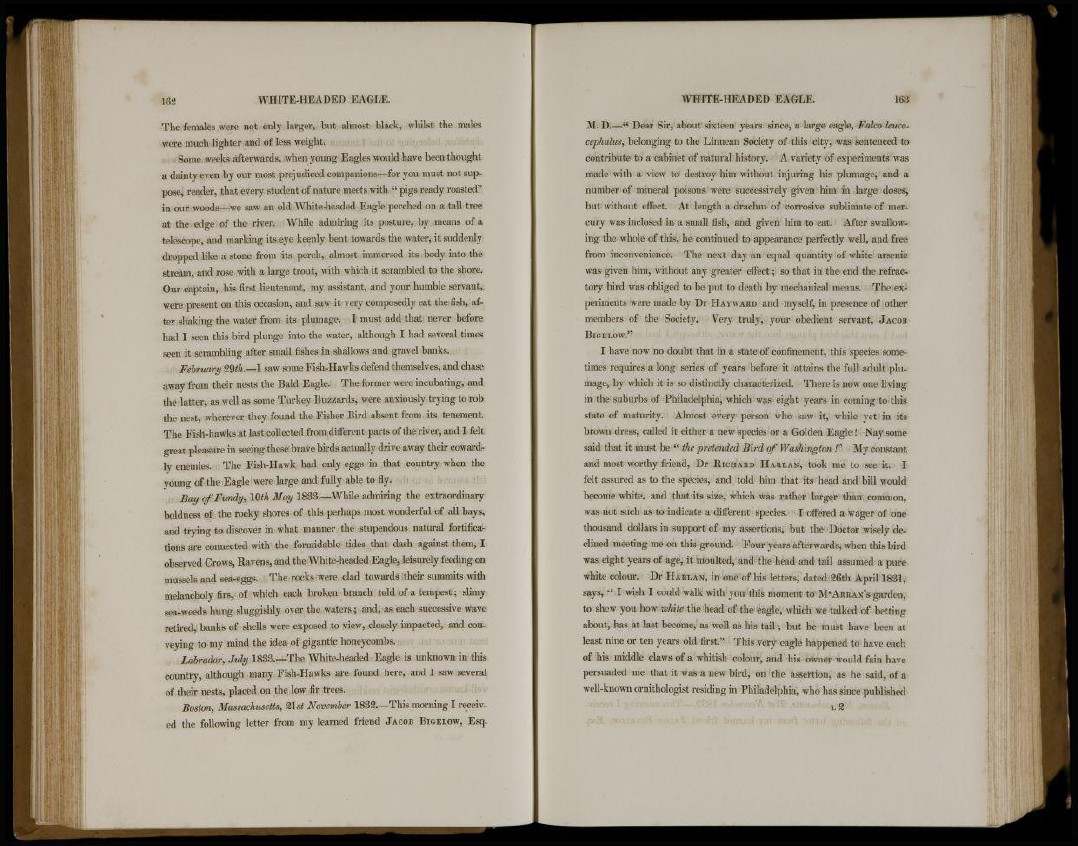
The females were not only larger, but almost black, whilst the males
were much lighter and of less weight.
Some weeks afterwards, when young Eagles would have been thought
a dainty even by our most prejudiced companions—for you must not suppose,
reader, that every student of nature meets with " pigs ready roasted1'
in our woods—we saw an old White-headed Eagle perched on a tall tree
at the edge of the river. While admiring its posture, by means of a
telescope, and marking its eye keenly bent towards the water, it suddenly
dropped like a stone from its perch, almost immersed its body into the
stream, and rose with a large trout, with which it scrambled to the shore.
Our captain, his first lieutenant, my assistant, and your humble servant,
were present on this occasion, and saw it very composedly eat the fish, after
shaking the water from its plumage. I must add that never before
had I seen this bird plunge into the water, although I had several times
seen it scrambling after small fishes in shallows and gravel banks.
February 9,9th.—I saw some Fish-Hawks defend themselves, and chase
away from their nests the Bald Eagle. The former were incubating, and
the latter, as well as some Turkey Buzzards, were anxiously trying to rob
the nest, wherever they found the Fisher Bird absent from its tenement.
The Fish-hawks at last collected from different parts of the river, and I felt
great pleasure in seeing these brave birds actually drive away their cowardly
enemies. The Fish-Hawk had only eggs in that country when the
voung of the Eagle were large and fully able to fly.
Bay qfFundy, 10th May 1833.—While admiring the extraordinary
boldness of the rocky shores of this perhaps most wonderful of all bays,
and trying to discover in what manner the stupendous natural fortifications
are connected with the formidable tides that dash against them, I
observed Crows, Ravens, and the White-headed Eagle, leisurely feeding on
mussels and sea-eggs. The rocks were clad towards their summits with
melancholy firs, of which each broken branch told of a tempest; slimy
sea-weeds hung sluggishly over the waters; and, as each successive wave
retired, banks of shells were exposed to view, closely impacted, and conveying
to my mind the idea of gigantic honeycombs.
Labrador, July 1833.—The White-headed Eagle is unknown in this
country, although many Fish-Hawks are found here, and I saw several
of their nests, placed on the low fir trees.
Boston, Massachusetts, %\st November 1832.—This morning I received
the following letter from my learned friend JACOB BIGELOW, Esq.
Mi 1).—" Dear Sir, about sixteen years since, a large eagle, Falco leucocephalus,
belonging to the Linnean Society of this city, was sentenced to
contribute to a cabinet of natural history. A variety of experiments was
made with a view to destroy him without injuring his plumage, and a
number of mineral poisons were successively given him in large doses,
but without effect. At length a drachm of corrosive sublimate of mercury
was inclosed in a small fish, and given him to eat. After swallowing
the whole of this, he continued to appearance perfectly well, and free
from inconvenience. The next day an equal quantity of white arsenic
was given him, without any greater effect; so that in the end the refractory
bird was obliged to be put to death by mechanical means. The experiments
were made by Dr HAYWARD and myself, in presence of other
members of the Society. Very truly, your obedient servant, JACOB
BIGELOW."
I have now no doubt that in a state of confinement, this species sometimes
requires a long series of years before it attains the full adult plumage,
by which it is so distinctly characterized. There is now one living
in the suburbs of Philadelphia, which was eight years in coming to this
state of maturity. Almost every person who saw it, while yet in its
brown dress, called it either a new species or a Golden Eagle ! Nay some
said that it must be " the pretended Bird of Washington ƒ" My constant
and most worthy friend, Dr RICHARD HARLAN, took me to see it. I
felt assured as to the species, and told him that its head and bill would
become white, and that its size, which was rather larger than common,
was not such as to indicate a different species. I offered a wager of one
thousand dollars in support of my assertions, but the Doctor wisely declined
meeting me on this ground. Four years afterwards, when this bird
was eight years of age, it moulted, and the head and tail assumed a pure
white colour. Dr HARLAN, in one of his letters, dated 26th April 1831,
says, u I wish I could walk with you this moment to M'ARRAX'S garden,
to shew you how white the head of the eagle, which we talked of betting
about, has at last become, as well as his tail; but he must have been at
least nine or ten years old first.1' This very eagle happened to have each
of his middle claws of a whitish colour, and his owner would fain have
persuaded me that it was a new bird, on the assertion, as he said, of a
well-known ornithologist residing in Philadelphia, who has since published
L2